Seitenstruktur
-
Spitsbergen-News
- Select Month
- March 2020
- February 2020
- March 2019
- January 2019
- December 2018
- September 2018
- June 2018
- May 2018
- April 2018
- March 2018
- February 2018
- January 2018
- December 2017
- November 2017
- October 2017
- September 2017
- June 2017
- May 2017
- April 2017
- March 2017
- February 2017
- January 2017
- December 2016
- September 2015
- April 2015
- March 2015
- February 2015
- January 2015
- December 2014
- October 2014
- August 2014
- June 2014
- May 2014
- April 2014
- March 2014
- November 2009
- April 2000
- Select Month

| Grytviken |
Home
→ Antarctica information
→ Antarctica travel information
Antarctica travel information
Antarctica travel information: ships, itineraries, when to travel
Some thoughts about planning a voyage.
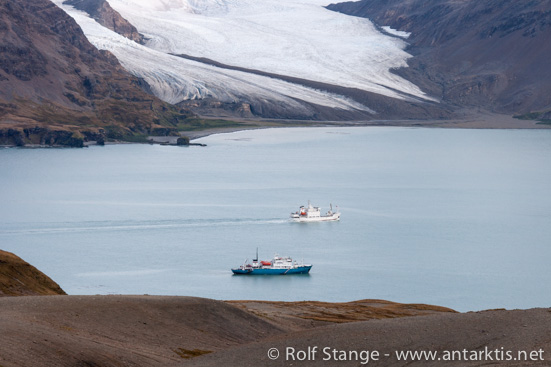
Two veterans of antarctic expedition cruising, now retired:
MV Professor Multanovskiy (blue hull) and MV Grigoriy Mikheev.
Antarctica is the remotest and most inaccessible of all continents. Getting there is pretty much impossible for the individual traveller, unless you call an ocean-going yacht your own and time and money are nothing you have to worry about. If time is an issue, but money isn’t, then your own private airplane might also be an option.
Ships
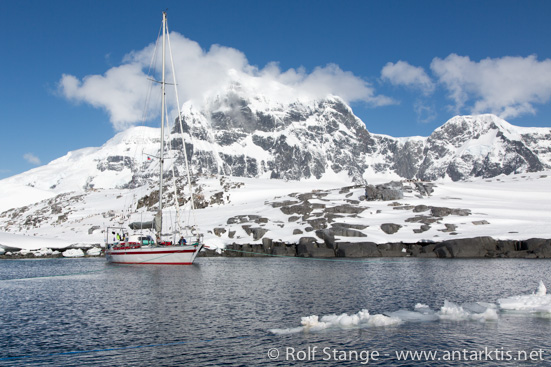
Sailing yacht (SY Pelagic) at Port Lockroy, Antarctic Peninsula.
But as most of us don’t have either of the above, let’s talk about ships. Once you start to investigate about a trip to Antarctica, the multitude of options soon seems confusing. For an overview, it makes sense to sort ships and itineraries into a few categories. Once you have decided which ones out of these suits you best, it is still early enough to worry about the details of the individual ships, trips and offers.
The most important factor for categorizing ships is the size in terms of passenger capacity. Simplified, there are the following options:
- Sailing boats. The number of yachts regularly travelling the Antarctic Peninsula or South Georgia is by now larger than most would believe. But it is definitely wise to have some sailing experience before you venture to Antartica with a yacht. The trips are much longer with these smaller, slower boats, where extra time to avoid heavy storms at open sea should always be available. But if you decide this is the right thing for you, then you are on for a very intense experience of nature with a solid expedition character and a good portion of adventure. There is also the barque Europa, a larger sailing ship often travelling these waters.
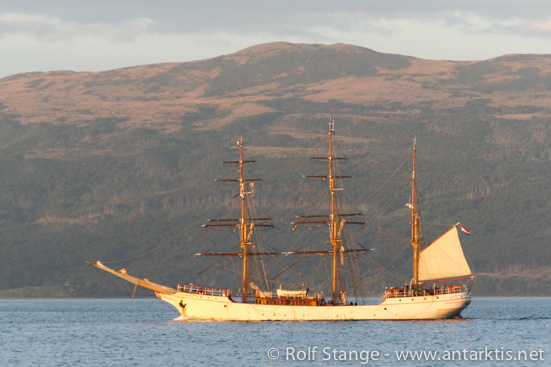
Bark Europa in the Beagle Channel, Tierra del Fuego.
- Expedition cruise ships with a maximum of 500 passengers. These ships offer daily landings for a first-hand nature experience. Up to 100 passengers are allowed on shore at one site at any time, meaning that ships with more than 100 guests will operate several groups who are taking shifts, reducing the shore time for the individual. The atmosphere of smaller ships up to 100 passengers is rather informal, you don’t have to look like a penguin to be allowed into the board restaurant for dinner and the bridge is open for passenger at almost any time on many of these expedition ships. Space and comfort in cabins and other public places as well as quality and choice of meals often increase together with the size of the ship, but at the cost of the time that you can spend on shore during landings. Some of the smaller ships offer additional activities such as kayaking, camping on shore for a night, hiking, snowshoeing etc.

Expedition ship (MV Ortelius), Gold Harbour, South Georgia.
- Cruise ships with more than 500 passengers don’t offer landings in Antarctica. This is a „cruise only“ way of travelling, where Antarctica provides a scenic background for the on-board programme.
Routes & Itineraries
Many antarctic tourists want a direct nature experience, wildlife, ice, scenery, and smaller expedition ships are accordingly a popular choice for travelling Antarctica. Such voyages are the most important segment of antarctic tourism. Expedition cruise ships travel mostly one of the following itineraries, with variations:
- A 10 or 11 day cruise to the Antarctic Peninsula is the classical itinerary that is the blueprint for most voyages to Antarctica. Included are a day in port, usually Ushuaia in southern Argentina, and two days crossing the Drake Passage both in the beginning and at the end of the trip, resulting in 5-6 days effectively spent in Antarctica. These days are usually full with spectacular impressions and activities, including a number of landings and encounters of penguins, seals and a good chance for whale watching. You are likely to see most large antarctic animals, the most important expection being the Emperor penguin, which is only rarely seen on these trips. The focus is the west coast of the Antarctic Peninsula.

Chinstrap penguins on Orne Island, Antarctic Peninsula.
- There are several variations of the classical Antarctic Peninsula itinerary: some trips focus on the Weddell Sea, meaning the northern east coast of the Antarctic Peninsula including offlying islands, a dash south to the Antarctic Circle or special expeditions to see an Emperor penguin colony, usually early in the season and involving helicopters.

Crossing the Antarctic Circle.
- The long trip: 3 weeks to the Falkland Islands, South Georgia and the Antarctic Peninsula, thus focussing not exclusively on Antarctica, but including some subantarctic wildlife jewels. But these come at a price, as they are very remote, and the whole itinerary includes some 3000 nautical miles. Approximately half of the time is accordingly spent at sea, and the whole trip is accordingly longer and the ticket comes at a price that others pay for a new car. But I dare to say that the memories from such a trip last longer than most cars. On this trip, you will see the most complete cross section of subantarctic and antarctic wildlife possible on any given trip. The most important species that you are unlikely to see are Emperor penguins and Ross seals. Otherwise, you will see more or less all of them, of course always depending a bit on the goodwill of mother nature.

South Georgia, a paradise of nature in the South Atlantic. Elephant seals, Gold Harbour.
- The Ross Sea: remote and far from the common routes in Antarctica, the Ross Sea attracts a small number of antarctic travellers who have mostly been to the Antarctic Peninsula on previous trips. Voyages to the Ross Sea start and finish usually in New Zealand, alternatively Australia, or are operated as a semi-circumnavigation of Antarctica from South America to New Zealand or vice versa. In the Ross Sea, it is definitely an advantage to have a ship equipped with helicopters to make remote places such as Taylor Valley, one of the famous McMurdo Dry Valleys, accessible. Because of the large distances, long duration and the scale of the whole operation, voyages into the Ross Sea require an amount of time and money that most normal people wouldn’t even consider to spend on any one journey. But what does „normal“ mean when we are talking about Antarctica?

Impossible to reach without helicopters: Canada Glacier in Taylor Valley, one of the famous McMurdo Dry Valleys in the Ross Sea.
- There are some trips that partly or completely rely on the use of aircraft, for example when crossing the Drake on a flight from Punta Arenas (Chile) to King George Island (South Shetland Islands) rather than on a ship. This of course saves twice 2 days during a trip, which are otherwise spent at sea in an often rather uncomfortable way, but it takes an experience from the journey which many would describe as a vital part of any trip to Antarctica. And if the weather in the South Shetlands is bad, then you may spend significant time waiting for departure in Punta Arenas, as landing on the airstrip on King George Island requires reasonably good conditions. There are also short trips to King George Island, possibly including an overnight there, but then all you will see of Antarctica is one of very few areas that most who have been down south and seen some more won’t describe as particularly attractive. There are also expensive expeditions for mountaineers who want to climb Mount Vinson, Antarctica’s highest mountain, which requires large-scale flight logistics via a base camp at Patriot Hills in the Weddell Sea, and if you want to, you can take the opportunity for a dash to the South Pole while you are there. All this will require amounts of money that might also be used for a whole couple of trips to the Antarctic Peninsula.
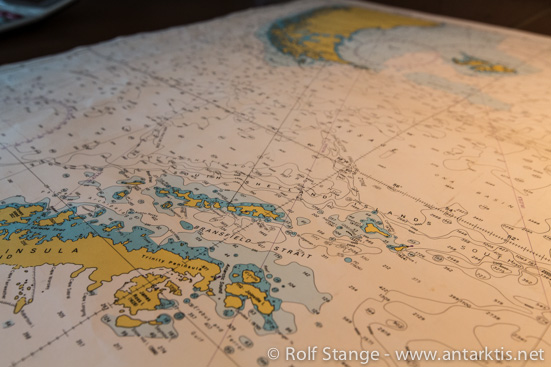
The Drake Passage is an integral part of Antarctica and should not be missed, although the crossing can certainly be uncomfortable.
When to travel: the season
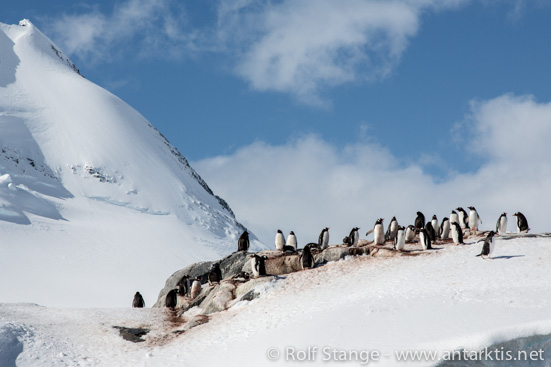
Lots of snow and ice in the early season. Port Lockroy, Antarctic Peninsula.
Antarctic tourism is naturally highly seasonal and limited to the austral summer. Peak season is from late November and into February, but the first ships are sailing south already in October and the last ones may endure increasingly tougher conditions in March or even into the first days of April.
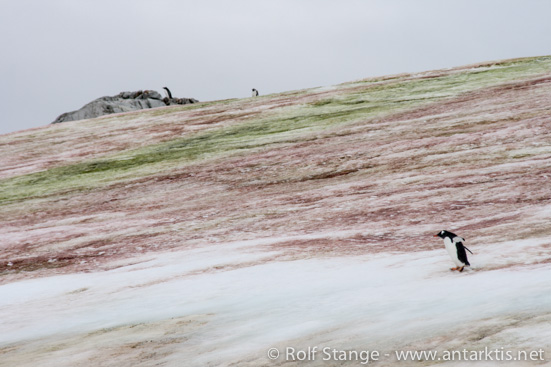
Snow algae and some rather lonely penguins in late March on Petermann Island, Antarctic Peninsula.
To keep it short: all parts of the seasons have their own beauty, character and highlights. There is no time that is a priori the best or absolutely to be avoided. If you want to see a bit of everything, then peak season should be the best time to come. In the early season, you will have a lot of ice and snow, giving the scenery a beautiful, virgin appearance, but the ice can also be an obstacle in terms of getting to certain areas and the snow can make moving around on shore quite cumbersome. From late December, penguin chicks are more easily seen, getting bigger and becoming the stars of any voyage to Antarctica in the second half of the season. In South Georgia, there are large numbers of impressive Elephant seals on the breeding beaches in the early season, lasting into November. A bit later, Fur seals come on shore to start their mating season in numbers large enough to make some beaches inaccessible at peak breading season. This includes Prion Island, the one and only site in South Georgia where mere mortals have a chance (and no more than that) to see the Wandering Albatross and their breeding sites. Prion Island is regularly closed in mid season and open again near mid January. You have to take this into consideration when planning your trip if you want your chance to see a Wandering Albatross at his home.
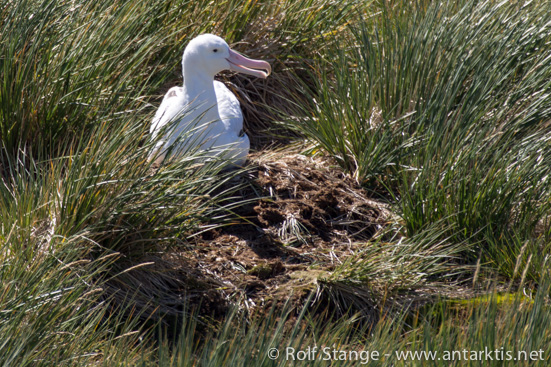
Wandering albatross on his nest on Prion Island, South Georgia. Prion Island is closed during the peak breading season of Fur seals and may not be visited before almost mid January.
Many penguins are leaving the colonies when the season is slowly approaching its end in March. You can see some late ones and moulting penguins into April, but the impression of teaming life is gone when the animals still there are limited to smaller numbers scattered between carcasses of those who didn’t make it. Darkness at night is quickly getting longer now, forcing ships to maneouvre more carefully in ice-infested waters, and the increasing frequency of strong low pressures is another reason why March is not peak season anymore. But of course a trip to Antarctica can be a stunningly beautiful at any time including March. In the end, it is the weather that decides, and it can be great or bad at any time.
Getting there and away
Most trips to Antarctica start with an international flight to Buenos Aires and a domestic flight to Ushuaia. That doesn’t just sound easy, it is actually easy. Nevertheless, some hints won’t do any harm.
- You will usually have to change between airports in Buenos Aires. It is a taxi ride of about 50 minutes in good conditions, but it can take considerably longer if there is a lot of traffic. If you spend a night in Buenos Aires, it is much safer in terms of getting your connecting flight, and of course more relaxed and enjoyable.
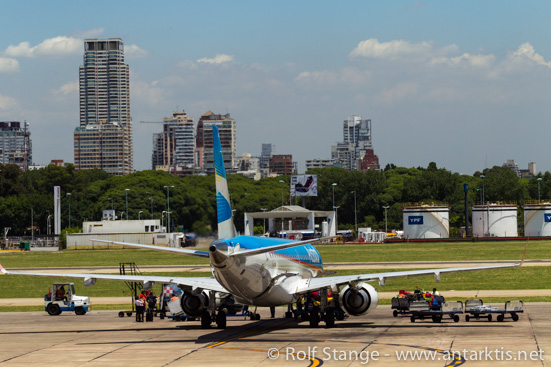
Takes time and sometimes a bit of nerves: airports in Buenos Aires and the transfer between them.
- You should definitely have an overnight in Ushuaia between your flight and boarding the ship, in case of any delay. Ships do usually not wait for individual passengers and certainly not for a suitcase that is coming with the next flight.
- The same goes for the return journey. Disembarkation is usually at 9 a.m. (local time), but there may be delays, be it because of an unexpected storm in the Drake Passage, a shortage of pilots (pilotage is compulsary in the Beagle Channel) of slow harbour procedures. It doesn’t happen too often, but never say never. And if you have booked your flight for the afternoon or the next day, then you can enjoy the extra time on board in a much more relaxed way than the guys who is already watching his plane on the runway with binoculars, while the harbour authorities are still sorting paperwork with the Captain.
- See also section about Ushuaia and the Beagle Channel.
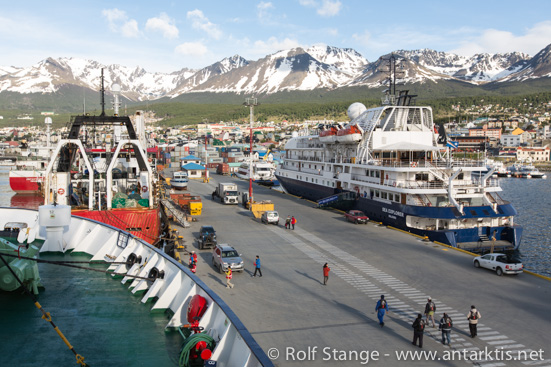
Harbour in Ushuaia.
last modification: 2014-05-15 ·
copyright: Rolf Stange

























